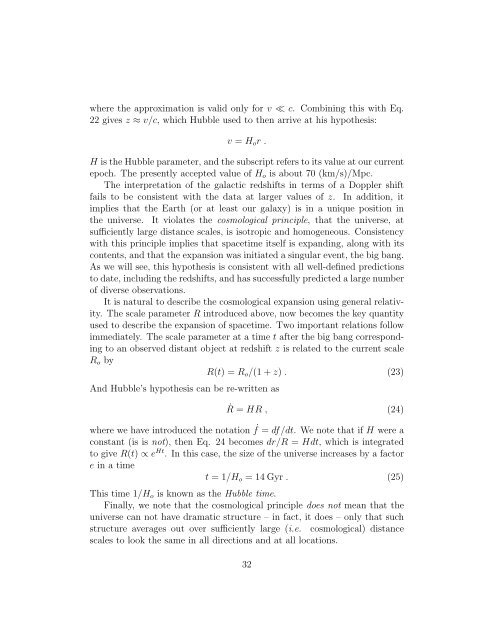Lecture Notes for Astronomy 321, W 2004 1 Stellar Energy ...
Lecture Notes for Astronomy 321, W 2004 1 Stellar Energy ...
Lecture Notes for Astronomy 321, W 2004 1 Stellar Energy ...
You also want an ePaper? Increase the reach of your titles
YUMPU automatically turns print PDFs into web optimized ePapers that Google loves.
where the approximation is valid only <strong>for</strong> v ≪ c. Combining this with Eq.<br />
22 gives z ≈ v/c, which Hubble used to then arrive at his hypothesis:<br />
v = H o r .<br />
H is the Hubble parameter, and the subscript refers to its value at our current<br />
epoch. The presently accepted value of H o is about 70 (km/s)/Mpc.<br />
The interpretation of the galactic redshifts in terms of a Doppler shift<br />
fails to be consistent with the data at larger values of z. In addition, it<br />
implies that the Earth (or at least our galaxy) is in a unique position in<br />
the universe. It violates the cosmological principle, that the universe, at<br />
sufficiently large distance scales, is isotropic and homogeneous. Consistency<br />
with this principle implies that spacetime itself is expanding, along with its<br />
contents, and that the expansion was initiated a singular event, the big bang.<br />
As we will see, this hypothesis is consistent with all well-defined predictions<br />
to date, including the redshifts, and has successfully predicted a large number<br />
of diverse observations.<br />
It is natural to describe the cosmological expansion using general relativity.<br />
The scale parameter R introduced above, now becomes the key quantity<br />
used to describe the expansion of spacetime. Two important relations follow<br />
immediately. The scale parameter at a time t after the big bang corresponding<br />
to an observed distant object at redshift z is related to the current scale<br />
R o by<br />
R(t) = R o /(1 + z) . (23)<br />
And Hubble’s hypothesis can be re-written as<br />
Ṙ = HR , (24)<br />
where we have introduced the notation ˙ f = df/dt. We note that if H were a<br />
constant (is is not), then Eq. 24 becomes dr/R = Hdt, which is integrated<br />
to give R(t) ∝ e Ht . In this case, the size of the universe increases by a factor<br />
e in a time<br />
t = 1/H o = 14 Gyr . (25)<br />
This time 1/H o is known as the Hubble time.<br />
Finally, we note that the cosmological principle does not mean that the<br />
universe can not have dramatic structure – in fact, it does – only that such<br />
structure averages out over sufficiently large (i.e. cosmological) distance<br />
scales to look the same in all directions and at all locations.<br />
32













